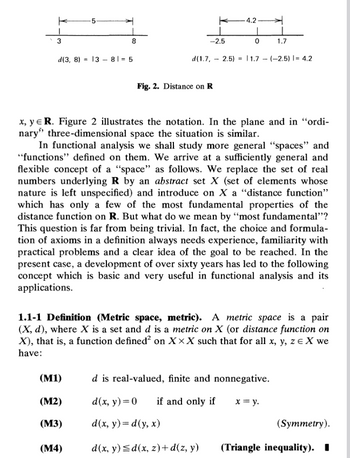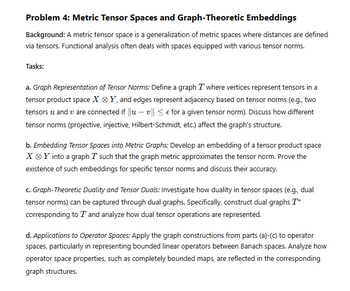
Advanced Engineering Mathematics
10th Edition
ISBN: 9780470458365
Author: Erwin Kreyszig
Publisher: Wiley, John & Sons, Incorporated
expand_more
expand_more
format_list_bulleted
Question
thumb_up100%
Make sure to answer by hand, make all graphs and give steps how you constructed these, DO NOT SOLVE USING AI
USE : https://drive.google.com/file/d/1a2B3cDeFgHiJkLmNoPqRsTuVwXyZz0/view?usp=sharing
For the reference, and the book kreyszig can be used,

Transcribed Image Text:3
K 5
8
K -4.2
-2.5
0
1.7
d(1.7, 2.5) 11.7 (-2.5) |= 4.2
-
=
-
d(3, 8) 13 81-5
Fig. 2. Distance on R
x, y = R. Figure 2 illustrates the notation. In the plane and in “ordi-
nary" three-dimensional space the situation is similar.
In functional analysis we shall study more general "spaces" and
"functions" defined on them. We arrive at a sufficiently general and
flexible concept of a "space" as follows. We replace the set of real
numbers underlying R by an abstract set X (set of elements whose
nature is left unspecified) and introduce on X a "distance function"
which has only a few of the most fundamental properties of the
distance function on R. But what do we mean by "most fundamental"?
This question is far from being trivial. In fact, the choice and formula-
tion of axioms in a definition always needs experience, familiarity with
practical problems and a clear idea of the goal to be reached. In the
present case, a development of over sixty years has led to the following
concept which is basic and very useful in functional analysis and its
applications.
1.1-1 Definition (Metric space, metric). A metric space is a pair
(X, d), where X is a set and d is a metric on X (or distance function on
X), that is, a function defined² on XXX such that for all x, y, z= X we
have:
d is real-valued, finite and nonnegative.
(M1)
(M2)
d(x, y)=0 if and only if
x = y.
(M3)
d(x, y) = d(y, x)
(Symmetry).
(M4)
d(x, y)d(x, z)+d(z, y)
(Triangle inequality). ■

Transcribed Image Text:Problem 4: Metric Tensor Spaces and Graph-Theoretic Embeddings
Background: A metric tensor space is a generalization of metric spaces where distances are defined
via tensors. Functional analysis often deals with spaces equipped with various tensor norms.
Tasks:
a. Graph Representation of Tensor Norms: Define a graph T where vertices represent tensors in a
tensor product space XY, and edges represent adjacency based on tensor norms (e.g., two
tensors u and v are connected if ||uv|| ≤ € for a given tensor norm). Discuss how different
tensor norms (projective, injective, Hilbert-Schmidt, etc.) affect the graph's structure.
-
b. Embedding Tensor Spaces into Metric Graphs: Develop an embedding of a tensor product space
XY into a graph T such that the graph metric approximates the tensor norm. Prove the
existence of such embeddings for specific tensor norms and discuss their accuracy.
c. Graph-Theoretic Duality and Tensor Duals: Investigate how duality in tensor spaces (e.g., dual
tensor norms) can be captured through dual graphs. Specifically, construct dual graphs T*
corresponding to T and analyze how dual tensor operations are represented.
d. Applications to Operator Spaces: Apply the graph constructions from parts (a)-(c) to operator
spaces, particularly in representing bounded linear operators between Banach spaces. Analyze how
operator space properties, such as completely bounded maps, are reflected in the corresponding
graph structures.
Expert Solution
This question has been solved!
Explore an expertly crafted, step-by-step solution for a thorough understanding of key concepts.
Step by stepSolved in 2 steps with 8 images

Knowledge Booster
Similar questions
- Discuss the duality principle in linear algebra, specifically in the context of vector spaces and their dual spaces.arrow_forwardLinear Algebra. What is a vector space axiom?arrow_forwardSuppose y1 ( x), y2 ( x), y3 ( x) are three different functions of x. The vector space they span could have dimension 1, 2, or 3. Give an example of y1, y2, y3 to show each possibility.arrow_forward
- Only part d please.arrow_forward1. Suppose that V is a vector space, v, w,x E V, and a and b are scalars. Fill in the empty boxes. Vector Space Property Name of Property, or FALSE v+w=w+v (a+b) (v+w) = av+bw v+(-v)=0 Scalar Multiplication is Associative (v+w)+x=v+(w+x) Multiplicative Identity Additive Identityarrow_forwardDalarrow_forward
- Let 2 3 2 X = X2 = X3 = 6. 3 4 4 (a) Show that x1, X2, and x3 are linearly dependent. (b) Show that x¡ and x2 are linearly independent. (c) What is the dimension of Span(x1, X2, X3)?arrow_forwardExplain if the statement is true or false, and whyarrow_forwardIf V1, V2, V3, V4, and W are all vector spaces. Are L(V1x...xV4, W) and L(V1, W) x...x L(V4, W) isomorphic vector spaces?arrow_forward
- Why do the set of all polynomials of degree n or less form a vector space, while the set of all polynomials of degree n or more do not?arrow_forwardPlease do Exericse 2.15 please show a proof with your answer. Please show step by step and explainarrow_forwardLetv1 =[1,4,-2] , v2 =[-2,-3,7] , b =[4,1,h]FIND all value(s) h such that b is in span{v1 , v2 }arrow_forward
arrow_back_ios
SEE MORE QUESTIONS
arrow_forward_ios
Recommended textbooks for you
 Advanced Engineering MathematicsAdvanced MathISBN:9780470458365Author:Erwin KreyszigPublisher:Wiley, John & Sons, Incorporated
Advanced Engineering MathematicsAdvanced MathISBN:9780470458365Author:Erwin KreyszigPublisher:Wiley, John & Sons, Incorporated Numerical Methods for EngineersAdvanced MathISBN:9780073397924Author:Steven C. Chapra Dr., Raymond P. CanalePublisher:McGraw-Hill Education
Numerical Methods for EngineersAdvanced MathISBN:9780073397924Author:Steven C. Chapra Dr., Raymond P. CanalePublisher:McGraw-Hill Education Introductory Mathematics for Engineering Applicat...Advanced MathISBN:9781118141809Author:Nathan KlingbeilPublisher:WILEY
Introductory Mathematics for Engineering Applicat...Advanced MathISBN:9781118141809Author:Nathan KlingbeilPublisher:WILEY Mathematics For Machine TechnologyAdvanced MathISBN:9781337798310Author:Peterson, John.Publisher:Cengage Learning,
Mathematics For Machine TechnologyAdvanced MathISBN:9781337798310Author:Peterson, John.Publisher:Cengage Learning,


Advanced Engineering Mathematics
Advanced Math
ISBN:9780470458365
Author:Erwin Kreyszig
Publisher:Wiley, John & Sons, Incorporated

Numerical Methods for Engineers
Advanced Math
ISBN:9780073397924
Author:Steven C. Chapra Dr., Raymond P. Canale
Publisher:McGraw-Hill Education

Introductory Mathematics for Engineering Applicat...
Advanced Math
ISBN:9781118141809
Author:Nathan Klingbeil
Publisher:WILEY

Mathematics For Machine Technology
Advanced Math
ISBN:9781337798310
Author:Peterson, John.
Publisher:Cengage Learning,

